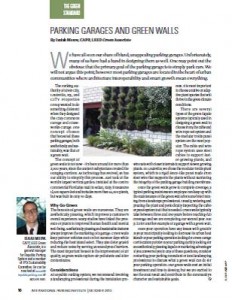 By Isaiah Mouw, CAPP, LEED Green Associate
By Isaiah Mouw, CAPP, LEED Green Associate
We have all seen our share of bland, unappealing parking garages. Unfortunately, many of us have had a hand in designing them as well. One may point out the obvious: that the primary goal of the parking garage is to simply park cars. We will not argue this point; however most parking garages are located in the heart of urban communities where architecture interoperability and smart growth mean everything.
The Parking Authority of River City, Louisville, Ky., and CITY Properties Group wanted to do something different when they designed the Clay Commons Garage and Glassworks Garage. One concept chosen that benefited these parking garages, both aesthetically and sustainably, was that of a green wall.
The concept of green walls is not new—it’s been around for more than 2,000 years, since the ancient Babylonians created the Hanging Gardens. As technology has evolved, so has our ability to simplify this process. Just look at the world’s largest vertical garden: installed at the Centro Commercial Fiordaliso mall in Milan, Italy, it measures 13,600 square feet and includes more than 44,000 plants, but was built in only 90 days.
Why Go Green
The benefits of green walls are numerous. They are aesthetically pleasing, which improves a customer’s overall experience. Many studies have linked the presence of plants to improved human health and mental well-being. Aesthetically pleasing and sustainable features always improve the marketing of a garage. Green walls keep patrons’ vehicles cool on hot summer days while reducing the heat island effect. They also deter graffiti and reduce noise by serving as soundproof barriers. The most important benefit is the improvement of air quality, as green walls capture air pollutants and filter contaminates.
Considerations
At Republic Parking System, we recommend involving a landscaping professional during the installation process. It is most important to choose a native or adaptive plant species that will thrive in the given climate conditions.
There are several types of the green façade systems typically used in designing a green wall to choose from; the cable and wire rope net system and the modular trellis panel system are the most popular. The cable and wire rope system uses steel cables to support faster-growing plants, and wire nets with closer intervals to support slower growing plants. In Louisville, we chose the modular trellis plant system, which is a rigid fence-like panel made from steel wire that supports the plants without sacrificing the integrity of the parking garage building membrane.
Once the green walls grow to complete coverage, a typical parking maintenance employee can keep up with the maintenance of the green wall after some brief training from a landscape professional. Usually, watering and pruning the plant and periodically inspecting the cable or panel system is all that is needed. Green walls typically take between three and five years before reaching full coverage and we are completing our second year. See p. 32 for another example of a garage with a green wall.
Does your operation have any issues with graffiti? Is your municipality looking to decrease its urban heat island? Is your parking operation looking for Green Garage Certification points? Is your parking facility looking for an aesthetically pleasing façade or marketing advantage? If you answered yes to any of these questions, consider contacting your parking consultant or local landscaping professional to discuss what a green wall can do for your parking operation. Our green walls cost an initial investment and time to develop, but we are excited to see the final result and contribute to the community’s character and sustainable goals.
Isaiah Mouw, CAPP, LEED Green Associate, is a general manager for Republic Parking System and a member of IPI’s Sustainability Committee. He can be reached at imouw@republicparking.com or 502.574.1497.
TPP-2013-10-Parking Garages and Green Walls
